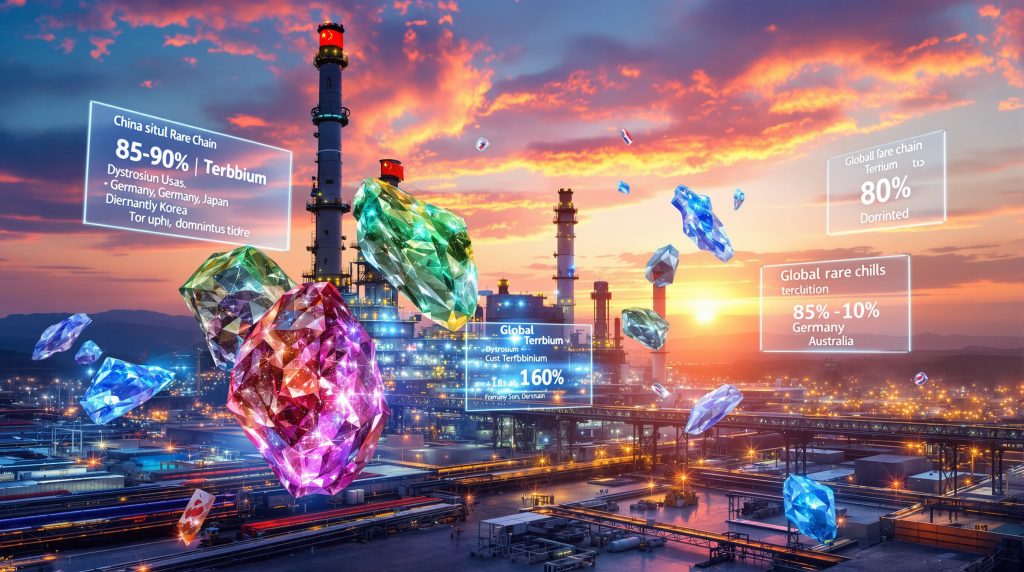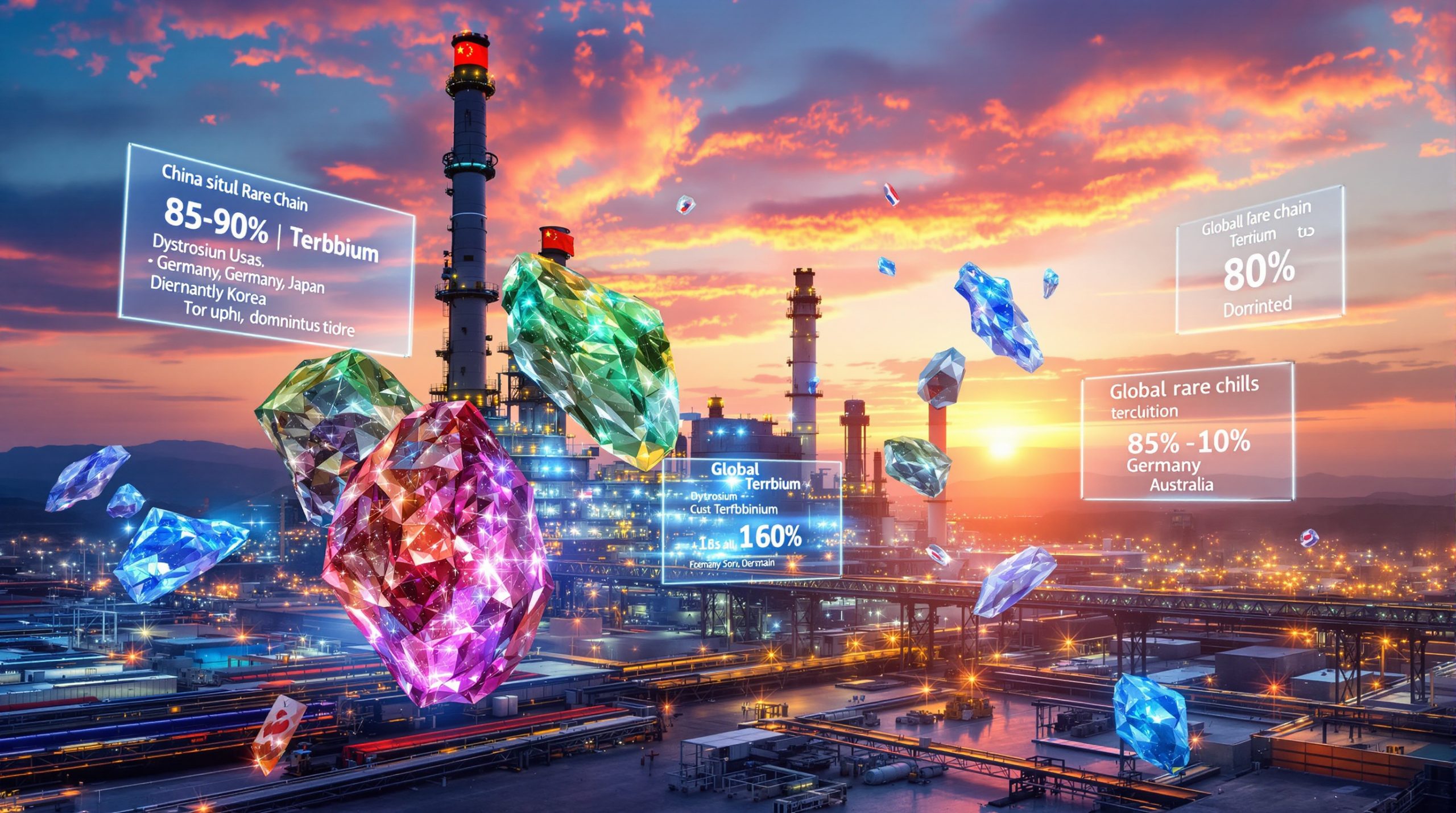China rare earth export controls have fundamentally reshaped global supply chain dynamics, creating strategic vulnerabilities across critical industries. These seventeen specialized elements, though comprising less than 0.1% of global mining output by volume, enable technologies that define modern industrial competitiveness. From permanent magnet motors in electric vehicles to precision-guided defense systems, rare earth elements create dependencies that transcend traditional commodity markets. Understanding how export controls reshape these supply chains requires examining the intersection of resource concentration, processing monopolies, and strategic leverage in an increasingly fragmented global economy.
Understanding China's Rare Earth Export Control Framework
China's rare earth export control system represents a sophisticated regulatory architecture designed to maximize strategic leverage while maintaining plausible commercial justification. The framework evolved through multiple phases, beginning with quotas and licensing requirements that appeared routine but progressively expanded into comprehensive oversight mechanisms affecting global supply chains.
Regulatory Evolution Timeline
The progression of China's rare earth export controls demonstrates calculated escalation rather than reactive policymaking. In April 2025, Beijing implemented licensing requirements covering seven critical rare earth elements, establishing 45-day minimum review periods that created immediate market uncertainty. The October 2025 expansion extended controls to twelve elements while introducing extraterritorial jurisdiction provisions that captured downstream products containing even minimal Chinese-sourced content.
The November 2025 temporary suspension of five elements marked a strategic pause rather than policy abandonment. This tactical retreat allowed China to gauge international responses while maintaining pressure on critical defense and semiconductor applications. Currently, seven elements remain under permanent control, with licensing authorities retaining discretionary extension powers that can extend review timelines indefinitely.
Industry sources report that the suspension period enabled Chinese officials to refine enforcement mechanisms and clarify end-use verification requirements. The retained controls on dysprosium and terbium specifically target high-performance magnet applications essential for defense systems and renewable energy infrastructure.
Legal Mechanisms and Enforcement Structure
China's Ministry of Commerce operates the licensing system through an integrated platform requiring detailed end-use documentation from foreign buyers. The 45-day minimum review period represents a floor rather than a ceiling, with national security assessments and resource conservation evaluations providing grounds for discretionary extensions.
Extraterritorial jurisdiction provisions require export licenses for products containing as little as 0.1% Chinese-sourced rare earth materials, regardless of final assembly location. This threshold captures automotive components, electronics, and defense systems assembled in third countries using Chinese rare earth inputs, effectively globalizing Chinese regulatory oversight.
The enforcement structure combines customs controls with end-user verification requirements that demand technical specifications often considered proprietary by foreign companies. This creates operational friction where compliance necessitates disclosure of sensitive manufacturing details, particularly affecting defense contractors and advanced technology manufacturers.
Table: Controlled Rare Earth Elements Under Current Framework
| Element | Control Status | Military Applications | Industrial Uses |
|---|---|---|---|
| Dysprosium | Permanent | Defense guidance systems | High-temperature magnets |
| Terbium | Permanent | Laser targeting systems | LED phosphors |
| Europium | Suspended | Night vision equipment | Display technologies |
| Ytterbium | Suspended | Fiber laser systems | Medical imaging |
| Yttrium | Permanent | Radar components | Ceramic applications |
| Lutetium | Permanent | Medical isotopes | Research applications |
| Holmium | Suspended | Nuclear reactors | Magnetic refrigeration |
How Do Export Controls Reshape Global Critical Mineral Markets?
Export controls fundamentally alter market dynamics by transforming commodity transactions into geopolitical relationships. The global rare earth market, previously characterized by price competition and supply optimization, now operates through a dual-tier system where access depends on political relationships and end-use classifications.
Processing Capacity Concentration Analysis
China's control extends beyond mining to encompass 70% of global rare earth extraction and 85% of refining capacity. More critically, approximately 90% of rare earth alloy and permanent magnet production occurs within Chinese borders, creating multiple chokepoints throughout the supply chain.
This concentration reflects decades of state-directed industrial development combined with environmental regulations in Western countries that made rare earth processing economically challenging. Furthermore, the energy transition in minerals has amplified demand for specific elements while the critical minerals strategy remains fragmented across different regions.
The processing monopoly means that even successful non-Chinese mining projects remain dependent on Chinese facilities for conversion to commercial products. Australian and American mines can produce rare earth concentrates, but these materials require Chinese processing capabilities to become useful industrial inputs.
Supply Chain Vulnerability Assessment
The automotive sector exemplifies supply chain vulnerability under export controls. Electric vehicles require 3-5 kg of rare earth magnets per traction motor, with 94% of electric vehicles currently using permanent-magnet architectures. This creates direct dependence on Chinese magnet production for global automotive electrification.
In 2025, Ford Motor Company experienced production disruptions at Chicago manufacturing facilities when Chinese suppliers faced export licensing delays. CEO Jim Farley described operations as functioning on a limited supply basis, illustrating how quickly regulatory uncertainty cascades through complex supply chains.
"Foreign buyers must navigate increasingly complex regulatory environments where end-use information is demanded but considered sensitive, creating operational friction that extends beyond simple procurement delays."
Tier-1 automotive suppliers, including companies like BorgWarner and ZF, reported inventory depletion within months of licensing tightening. This demonstrates how quickly buffer stocks can be exhausted when regulatory predictability declines, forcing manufacturers to operate with minimal safety margins.
Sector-Specific Impact Evaluation
Different industries experience varying degrees of export control impact based on their strategic sensitivity and availability of alternatives:
- Defense contractors face automatic license rejections for applications involving guidance systems, radar components, and advanced electronics
- Semiconductor manufacturers encounter case-by-case reviews for advanced chip production, particularly processes below 14 nanometers
- Renewable energy companies experience procurement delays affecting wind turbine and solar panel production schedules
The defense sector confronts the most severe restrictions, with Chinese authorities maintaining comprehensive denial lists for military end-uses. Semiconductor companies face uncertain review timelines that complicate production planning, while renewable energy manufacturers navigate delays that affect project completion schedules.
What Are the Economic Implications of Rare Earth Trade Restrictions?
Export controls create market segmentation that fundamentally alters pricing mechanisms and competitive dynamics across affected industries. In addition, the European CRM facility insights demonstrate how traditional commodity markets assume fungible supply sources, but China rare earth export controls create preferred and restricted buyer categories with dramatically different access conditions.
Market Price Dynamics Under Control Regimes
Non-Chinese rare earth sources command 10-30% price premiums over Chinese baseline pricing, reflecting both limited alternative supply and regulatory risk premiums. Korean companies report paying 15-20% above Chinese prices for Vietnamese-sourced magnets to reduce supply chain exposure.
Neo Performance Materials' Estonia magnet facility experienced surge demand following Chinese export control announcements, with European automotive suppliers accepting elevated pricing for supply security. This pricing differential reflects the premium markets assign to regulatory predictability over cost optimization.
Consequently, long-term contract negotiations increasingly incorporate force majeure clauses related to export licensing delays. Buyers seek contract terms that provide protection against regulatory disruptions, while suppliers demand pricing adjustments to compensate for compliance costs and uncertainty.
Industrial Competitiveness Effects
Table: Affected Industries and Vulnerability Levels
| Sector | Dependence Level | Alternative Sources | Timeline Risk |
|---|---|---|---|
| Defense Electronics | Critical | Severely Limited | Immediate |
| EV Manufacturing | High | Developing | 6-12 months |
| Semiconductor Fab | High | Emerging | 12-18 months |
| Medical Devices | Moderate | Available | 12-24 months |
| Wind Energy | High | Limited | 18-30 months |
| Consumer Electronics | Moderate | Multiple | 24-36 months |
Industries with critical dependencies face immediate competitiveness impacts when Chinese supply becomes unreliable. Defense electronics manufacturers must redesign systems around non-Chinese components, often accepting performance compromises or significant cost increases.
Electric vehicle manufacturers experience cascading effects through their supply chains, as Tier-1 suppliers face inventory constraints and procurement uncertainty. Production scheduling becomes more complex when critical component availability depends on export licensing timelines.
Regional Economic Security Considerations
Export controls highlight asymmetric vulnerabilities across different economic regions. The European Union faces particular exposure due to limited domestic rare earth processing capabilities despite strong automotive and renewable energy sectors requiring these materials.
The United States maintains some domestic rare earth mining capacity but lacks comprehensive processing infrastructure. This creates situations where American-mined materials require Chinese processing before returning as finished products, subjecting domestic resources to foreign regulatory control.
However, initiatives such as the Australian critical minerals reserve represent attempts to address these vulnerabilities. Japan and South Korea experience acute vulnerability despite technological sophistication, as their advanced manufacturing sectors depend heavily on Chinese rare earth inputs with limited alternative sources available in the near term.
Which Countries Face the Greatest Strategic Exposure?
Strategic exposure to China's rare earth export controls varies based on industrial structure, domestic resource availability, and existing supply chain relationships. Countries with advanced manufacturing capabilities but limited rare earth processing infrastructure face the most acute vulnerabilities.
Dependency Mapping by Geographic Region
North American exposure centres on automotive and defence sectors, where Canada and the United States maintain mining capabilities but lack comprehensive processing infrastructure. Mexico's automotive assembly operations depend entirely on imported rare earth components, creating direct exposure to Chinese export policies.
European dependencies span multiple critical sectors including automotive, renewable energy, and advanced manufacturing. Germany's automotive industry and Denmark's wind energy sector face particular vulnerability, as these industries drive significant portions of national economic output yet depend on Chinese rare earth inputs.
Asian manufacturing dependencies create complex regional dynamics where technologically advanced countries like Japan and South Korea rely on Chinese rare earth processing despite political tensions. Taiwan's semiconductor industry faces dual exposure through both rare earth requirements and geopolitical pressures.
National Security Risk Assessments
Countries most exposed to China's rare earth export controls include those with advanced manufacturing sectors lacking domestic processing capabilities. The United States, Germany, Japan, and South Korea represent the highest-risk category due to their combination of strategic industries and supply chain vulnerabilities.
Critical infrastructure risks extend beyond manufacturing to include power grid components, telecommunications equipment, and transportation systems that depend on rare earth-enabled technologies. Wind turbines, electric grid transformers, and advanced radar systems create potential vulnerabilities in national infrastructure.
Furthermore, defence capability maintenance faces immediate risks where weapons systems, guidance technologies, and communication equipment require continuous rare earth inputs. Military readiness could be compromised if export controls prevent maintenance of existing systems or procurement of new capabilities.
How Are Nations Responding to Supply Chain Vulnerabilities?
Government and industry responses to rare earth supply vulnerabilities demonstrate recognition that market-based solutions alone cannot address strategic dependencies. Coordinated approaches combining domestic capacity building, international partnerships, and technology development represent emerging strategies for reducing Chinese leverage.
Domestic Capacity Building Initiatives
The United States allocated substantial funding through the Critical Materials Institute and Defence Production Act investments to establish domestic rare earth processing capabilities. MP Materials' California facility represents the most advanced Western rare earth processing operation, though capacity remains limited compared to Chinese facilities.
European Union initiatives under the Critical Raw Materials Act target domestic magnet production and recycling capabilities. Germany and Estonia lead European efforts to establish non-Chinese magnet manufacturing, with Neo Performance Materials' Estonia facility serving as a key Western production node.
Australia leverages its substantial rare earth reserves through partnerships with international technology companies seeking supply chain diversification. Lynas Corporation's Malaysian processing facility provides one of the few large-scale alternatives to Chinese rare earth refining.
International Cooperation Frameworks
The US-Australia Critical Minerals Partnership encompasses an $8.5 billion commitment spanning mining, processing, and technology development initiatives. This partnership aims to create an integrated Western rare earth supply chain from mine to finished product.
For instance, Quad nations (United States, Japan, Australia, India) established supply chain resilience initiatives specifically targeting critical minerals. These frameworks coordinate investment policies, technology sharing, and procurement strategies to reduce collective dependence on Chinese sources.
NATO developed critical materials working groups addressing defence supply chain vulnerabilities. Alliance members coordinate stockpiling strategies and alternative sourcing requirements for defence-related rare earth applications.
Alternative Technology Development Programs
Research initiatives focus on reducing rare earth requirements rather than simply diversifying sources. AI-optimised motor designs achieve approximately 24% reductions in rare earth intensity while maintaining performance characteristics, demonstrating technology's potential for demand reduction.
Recycling technology advancement targets end-of-life products containing rare earth components. Renault's recycling programme processes approximately 400,000 end-of-life vehicles annually, though recovered rare earth volumes remain small relative to new demand.
Substitution material research explores alternatives to rare earth permanent magnets, including ferrite magnets and electromagnetically excited motor designs. While these alternatives often involve performance trade-offs, they provide options for applications where rare earth access becomes problematic.
What Does the Future Hold for Rare Earth Trade Policy?
The trajectory of rare earth trade policy reflects broader geopolitical trends toward economic nationalism and strategic competition. Future developments will likely balance escalatory pressures with recognition of mutual dependencies that affect all participants in global supply chains, particularly given the US-China trade impacts on critical mineral sectors.
Potential Escalation Scenarios
Expanded element coverage represents the most likely escalation pathway, with Chinese authorities potentially extending controls to additional rare earth elements or reducing threshold levels for existing restrictions. Light rare earth elements like neodymium and praseodymium could face licensing requirements despite their broader industrial applications.
Technology transfer restrictions might accompany export controls, requiring foreign companies to share technical knowledge or establish Chinese partnerships to maintain supply access. This approach would leverage rare earth dependencies to extract broader technological concessions.
Personnel mobility limitations could restrict movement of technical experts between Chinese rare earth facilities and foreign companies, complicating international partnerships and technology transfer arrangements that currently help bridge supply gaps.
De-escalation Pathway Analysis
Trade agreement negotiations provide potential frameworks for managing rare earth supply relationships through formal mechanisms. Bilateral agreements could establish guaranteed supply allocations in exchange for technology sharing or other economic concessions.
Mutual dependency recognition increasingly affects Chinese policy calculations as domestic industries require international markets for finished products incorporating rare earth components. China's new export controls on critical minerals demonstrate how supply concentration risks have become a reality, but Chinese magnet manufacturers also depend on global automotive and electronics demand, creating incentives for stable supply relationships.
Multilateral governance mechanisms through organisations like the World Trade Organisation might provide forums for establishing international norms around critical mineral trade, though enforcement remains challenging given strategic sensitivities.
Long-term Strategic Implications
"The temporary suspension signals a pause in escalation rather than abandonment of Beijing's broader objective to consolidate control over global rare earth and advanced materials supply chains."
Long-term trends point toward permanent market fragmentation where rare earth supply chains operate through politically aligned networks rather than purely economic relationships. Western allies will likely develop integrated supply chains that exclude Chinese participation, while China builds alternative networks serving different geopolitical alignments.
Technology development timelines suggest that significant rare earth demand reduction through substitution remains years away for most applications. This creates extended periods where geopolitical relationships will primarily determine access to these critical materials. Additionally, reports on China's rare earth export restrictions indicate this represents a new non-tariff battlefield in global trade competition.
The rare earth market may evolve into multiple parallel systems where prices, quality standards, and availability differ based on political relationships rather than purely economic factors. This fragmentation could persist for decades given the specialised infrastructure required for rare earth processing.
Frequently Asked Questions About China's Export Controls
Which rare earth elements are currently restricted?
Seven rare earth elements remain under permanent export licensing control following the November 2025 suspension. These include dysprosium, terbium, yttrium, lutetium and three additional heavy rare earth elements critical for defence applications and high-performance permanent magnets. Five elements including europium and ytterbium had their controls suspended but could face reinstatement.
How long do export licenses take to process?
Export licence applications require a minimum 45-day review period, though actual processing times often extend significantly longer. Chinese authorities retain discretionary power to extend reviews indefinitely for applications involving sensitive end-uses or national security considerations. Defence-related applications typically face automatic rejections, while commercial applications experience case-by-case evaluations.
Can companies circumvent controls through third countries?
China's extraterritorial jurisdiction provisions prevent circumvention through third-country processing or assembly. Products containing as little as 0.1% Chinese-sourced rare earth materials require export licences regardless of final manufacturing location. This threshold captures automotive components, electronics, and industrial equipment assembled outside China using Chinese rare earth inputs.
What alternatives exist to Chinese rare earth supplies?
Limited alternative sources include Neo Performance Materials' Estonia facility, MP Materials' California operations, and several emerging Asian processors. However, these alternatives currently handle only a small fraction of global demand and often charge 10-30% price premiums. Most alternatives focus on specific elements or applications rather than comprehensive rare earth processing capabilities.
How do export controls affect electric vehicle production?
Electric vehicle manufacturing faces direct impact because 94% of EVs use permanent-magnet motor architectures requiring 3-5 kg of rare earth magnets per vehicle. Export licensing delays create production scheduling uncertainty, while alternative magnet sources charge premium pricing. Some manufacturers are developing magnet-free motor designs, but these remain limited in application.
What recycling options exist for rare earth materials?
Rare earth recycling remains technically challenging and economically limited. Renault's programme processes approximately 400,000 end-of-life vehicles annually, but recovered rare earth volumes remain minimal compared to new demand. Recycling typically focuses on permanent magnets from hard drives and electric motors, though processing costs often exceed new material prices.
Strategic Recommendations for Industry Stakeholders
Strategic responses to China rare earth export controls require coordinated approaches addressing immediate procurement challenges while building long-term supply chain resilience. Companies must balance cost considerations with supply security while governments develop supportive policy frameworks.
Risk Mitigation Strategies
Diversified supplier development represents the most critical immediate strategy, though options remain limited. Companies should establish relationships with Neo Performance Materials, MP Materials, and emerging Asian processors despite premium pricing. Multiple supplier agreements provide hedge against single-source disruptions even when alternatives cost more.
Strategic inventory management requires balancing carrying costs against supply uncertainty. Companies should maintain 90-120 day inventory buffers for critical rare earth components, understanding that this approach increases working capital requirements but provides operational flexibility during licensing delays.
Alternative technology investment focuses on reducing rare earth intensity rather than complete elimination. AI-optimised motor designs achieving 24% rare earth reductions demonstrate viable approaches for maintaining performance while reducing dependency. Companies should evaluate rare earth-free technologies for future product generations while accepting near-term dependencies.
Policy Engagement Approaches
Government liaison coordination helps companies navigate export licensing requirements and understand regulatory developments. Regular communication with trade promotion agencies and embassy commercial sections provides early warning of policy changes affecting supply chains.
Industry association participation enables collective advocacy for policy solutions addressing shared vulnerabilities. Organisations like the Critical Materials Institute and European rare earth industry groups coordinate stakeholder positions and recommend government responses to supply chain challenges.
International standards development supports creation of technical specifications enabling alternative rare earth sources. Industry participation in standards organisations helps establish qualification criteria that facilitate supplier diversification beyond Chinese sources.
Long-term Planning Considerations
Supply chain resilience investment requires sustained commitment to building alternative infrastructure despite higher near-term costs. Companies should support Western rare earth processing development through long-term purchase agreements and joint investment arrangements.
Technology roadmap adaptation incorporates rare earth availability constraints into product development planning. Engineering teams should evaluate rare earth requirements during design phases and prioritise technologies offering supply chain flexibility.
Geopolitical risk assessment integration makes rare earth supply considerations part of broader strategic planning processes. Companies should model scenarios including expanded export controls, complete supply cutoffs, and alternative technology deployment timelines to inform investment decisions.
The rare earth supply landscape will remain characterised by strategic competition and technological innovation for the foreseeable future. Success requires companies to simultaneously manage immediate procurement challenges while investing in long-term alternatives that reduce strategic dependencies. Government policies supporting domestic capacity building and international cooperation provide essential foundations for private sector adaptation strategies.
Looking to Navigate the Evolving Critical Minerals Landscape?
Discovery Alert's proprietary Discovery IQ model delivers real-time alerts on significant ASX mineral discoveries, empowering subscribers to identify actionable opportunities ahead of broader markets facing supply chain disruptions. Stay informed about emerging mining developments that could reshape critical mineral supply chains by exploring Discovery Alert's discoveries page and begin your 30-day free trial today to position yourself strategically in an increasingly complex global minerals market.




